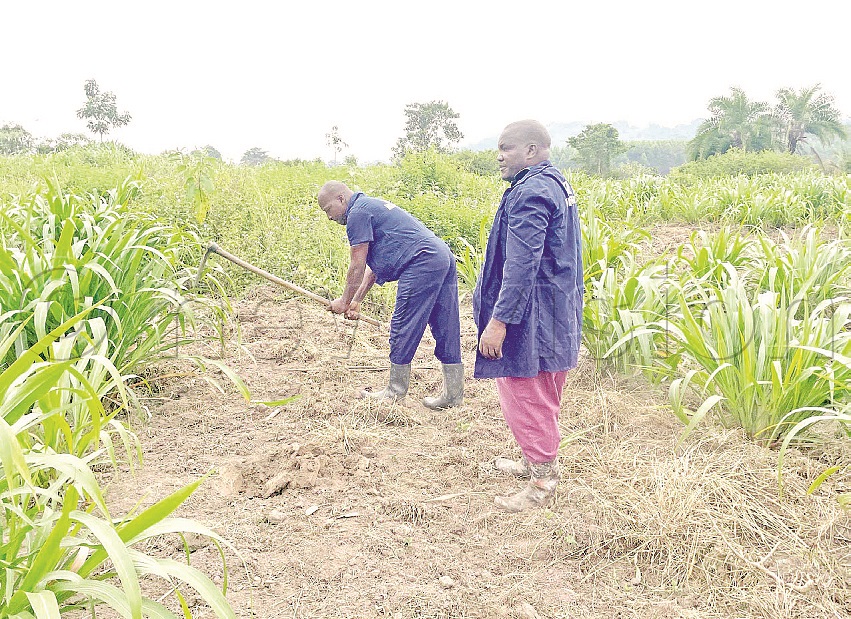By Ibrahim Ruhweza
From the farm to the bank, Moses Kazibwe’s earnings from grass are a testament to the power of creativity, hard work, and smart decision-making.
Kazibwe, 47, started with only three plants of guatemala grass as seeds, but now they cover most of his more than one square mile of land in Budonga village, Katika Mpanda parish, Mpenja sub-county, Gomba district. He named his farm MK Mixed Farm.
A civil engineer, Kazibwe had a dream of setting up one of the biggest farms in the country, to improve modern farming and inspire other farmers.
He began with rearing goats only; they kept on increasing up to 800 today. The higher the number, the higher the demand for feeds.
This forced Kazibwe to look for means of sustaining his animals and, hence, the idea of planting guatemala grass. Today, Kazibwe produces excess feeds that his animals cannot finish, so he resorted to selling the surplus to other farmers.
“Mixed farming is not only for making money, but also conserving the environment,” he says.
Guatemala grass only takes four months to grow and get harvested, and from there, it only takes two months to be harvested again. The more it grows, the more it feeds many animals.
“One fully grown plant can feed six mature animals,” he says.

He adds that animals like it because it is sweet and has glucose, making it look like sugarcane.
“Each season, starting in 2025, I plan to start producing 200-300tonnes of silage, and each tonne will cost sh3m,” he says. According to his explanation, Kazibwe will be making over sh160m each month after feeding his own animals. “
When there is drought, the cost of food also goes up,” he says.
By the time of the visit, the animals were few, and he notes that at first when the feeds were insufficient, he thought of reducing the goats from 800 to 200.
Kazibwe has planned to stock over 5,000 heads of cattle by next year since the feed will be enough for the available animals, and he will sell the extra. “If we have enough feed, we can raise thousands of animals,” he notes.
Product description
Guatemala grass is a robust, strongly rhizomatous, tufted, and leafy perennial grass that can form large bunches. The stems can be up to 3.5-4.5m high and up to 1-5cm in diameter.
Guatemala grass remains leafy for a long time. The roots are shallow, and the plant does not grow well during periods of long drought.
As the grass matures, the roots become stronger and store nutrients that will be necessary for regrowth after cutting. The leaves are tall (0.4-1.2m long and 9cm broad), glabrous, or sparsely hairy.
The flowerings are subdivided into 3-8cm slender, elongated racemes, up to 20cm long, containing male and female spikelets (3-5mm long).
Flowers are mostly sterile, and guatemala grass is usually propagated by stem cuttings or tuft division. Guatemala grass is cultivated primarily for fodder in cut-and-carry systems. It can also be used to make silage.
About guatemala grass
Guatemala grass originated in Mexico and South America and has been introduced for fodder in many tropical countries. It is a warm-season grass that grows from sea level up to an altitude of 1800m, at temperatures ranging from 18°C to 30°C.
It does better under good soil moisture, but can withstand short droughts. It is intolerant of waterlogging and flooding. It can grow on a wide range of soils and withstands low pH and the presence of Al, provided the soils are well-drained.
Other benefits
Farmers from Kenya, Somalia, and Nigeria have contacted Kazibwe for seedlings and knowledge on how to grow the plant on their own. All these come with a cost, which he adds to the money he makes from selling the feeds.
A determined farmer willing to turn every challenge into an opportunity, Kazibwe is anticipating becoming one of the best farmers in Africa.
He believes that starting next year when all plants have matured, different people will be coming to learn from him.
What others say
Isaac Mukwaya from Budonga village, Katika Mpanda parish, says the farm is too big, which means employment opportunities for the youth within the community.
Adding to that, Kazibwe provides market to small farmers who sell their animals at any time due to uncertainties. Mukwaya admits that locals have daily access to the farm to learn more about farming skills.
Environmental benefits
The more guatemala grass grows, the more it protects the environment through soil erosion protection, the formation of soil nutrients, and rain formation through evaporation.
The leftovers are also used for mulching, which is crucial to keeping the soils wet and supporting quick growth.
Challenges
Moses Kazibwe says maintaining a large number of animals is one of the greatest challenges in management.
The farm is so big that it needs a huge number of helpers, most of whom are inconsistent. Kazibwe also decries fake medicine used to treat animals.
He faults the ministry that is supposed to check the quality for having remained silent on the issue. Managing a big farm calls for external support, which he hardly gets from government.
“The Government should empower its people through loans with no interest to support interested farmers,” he says.
The farm not only runs guatemala grass but also other crops such as coffee, plantains, cassava, and aloe vera.
All these need enough support for proper maintenance.





